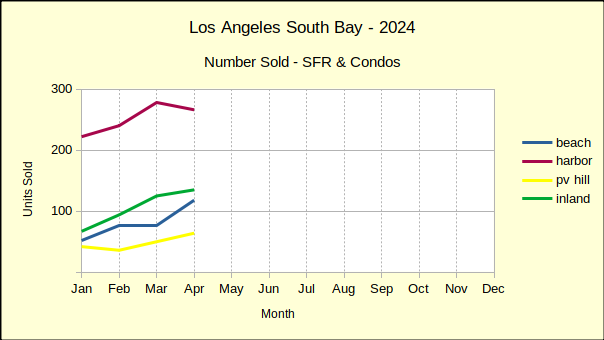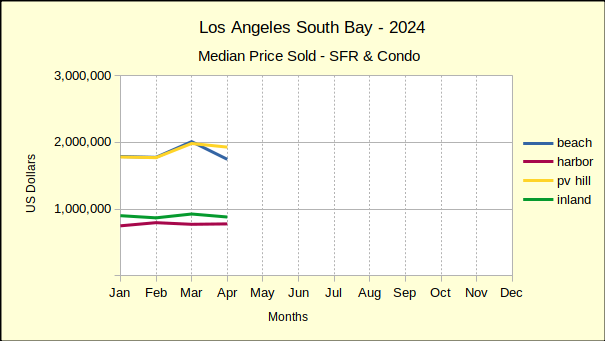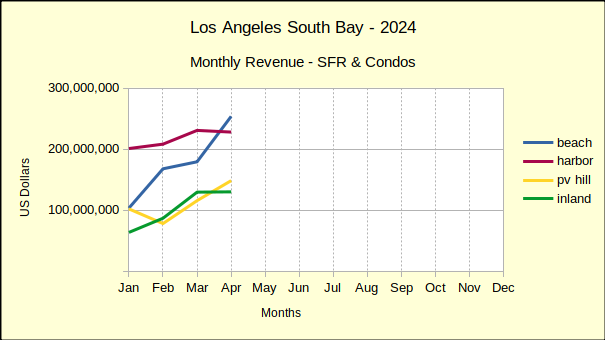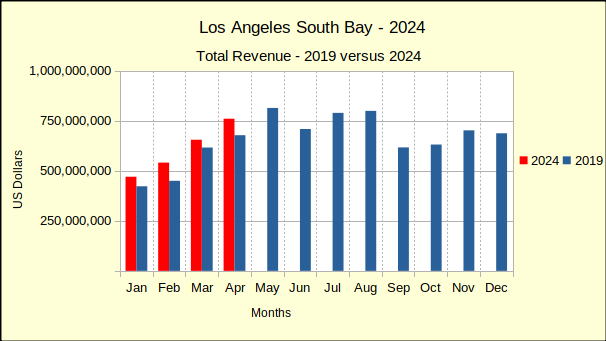South Bay:
Could it be that after several years of insanely steep ups and downs in the real estate market, we’re finally starting to see normal sales levels and prices? One could draw that conclusion after looking at the year to date statistics for the first four months of 2024 compared to last year. Instead of crazy double digit increases and decreases the rate of change has slowed to single digits almost everywhere.
The Beach cities have been the exception with a 19% growth in the number of homes sold through April compared to 2023. That compares to an average across the South Bay of 4% growth. That’s a good sign, but sales are still off by about 20% compared to the same period in 2019, the last year of “normal business” prior to the economic turmoil of the pandemic.

Median pricing continues to escalate also, though at a much reduced pace. For the first four months of 2024, year to date median prices increased in the 5%-9% range. This is a considerable drop from price jumps of as much as 29% seen just a few months ago.
Looking back at the historical data shows that when the pandemic first hit median prices were operating on a relatively normal upward path. Monthly gains were modest fractions of a percent. Then the Federal Reserve slashed the interest rates to keep the economy moving, and the median price shot through the ceiling with monthly increases frequently topping 30%.
August of 2022 saw a price peak and median prices have been falling since. There’s a lot of resistance on the part of sellers, of course. But the sales volume remains low by historical standards, and buyers are demanding price cuts to compensate for the higher mortgage interest rates, if nothing else.
Expect to see mixed results over the coming months as prices and interest rates ebb and flow around a fluctuating political scene, both nationally and internationally.
Beach:
Monthly sales volume took an insane 55% leap at the Beach in April, after having fallen 1% in March. Seeing the median price plummet by 13% for the same period helps to explain the shift. It’s an isolated example of the push and pull of prices and interest rates. Buyers will remain constrained in their ability to purchase, either by rates, or by artificially inflated prices, until sellers reach a “need to move” point where they are willing to reduce asking prices.

Year over year sales show a similar response in the comparison to last April—a 31% growth in number of homes sold against a 1% decline in the median price.
Trends are better demonstrated in the year to date statistics. Looking at the first four months of 2024 and comparing to the same period in 2023 shows the sales volume increased by 19% while the median price increased 5%
Making the same comparison between 2019 and 2024 shows a 32% decline in the number of homes sold this year. Median price is sharply higher by 43%.
Harbor:
The Harbor area appears to be stabilizing ahead of the other South Bay areas. April sales volume declined at the Harbor by 4% versus sales in March, while median prices increased 1%. Smaller monthly movement, especially in price, is essential to reduce inflation and put the real estate economy back on a solid footing. It’s hard to argue that inflation is near 2% annually, while real estate prices are escalating at several times that goal.
Clearly there’s still a ways to go considering the April 2024 volume had zero growth compared to last April, and is still 24% below April of 2019. The median price has a similar issue being up 7% over April 2023, while holding at 44% above April of 2019.

Year to date, 2024 versus 2023, the number of home sales is off by 1% and the median price is up 8%. The elephant in the room is the constantly increasing median price, which is pushing up hard against the Fed’s inflation battle. The price keeps going up because the inventory is exceptionally limited. There were 18% fewer homes sold year to date in 2024 than in 2019. The limited selection compared to the pent up demand pushed the median up some more.
Anecdotally, many pundits point to the extremely low interest rates of the pandemic years as a big driver for the low inventory and bidding wars. Home owners who refinanced to rates well below 5% are reluctant to sell those properties and take up new loans at often double the interest rate. Consequently, homes that would have gone on the market are now artificially being held off the market.
Hill:
As usual, home sales on the Palos Verdes peninsula have been all over the map in recent months. The number of homes sold in April climbed 28% compared to March, when it jumped 39% versus February, when sales dropped 14%. The median price started with 0% change in January and has yo-yoed it’s way through the first four months, ending down 3% in April from March.
While monthly sales statistics are often sporadic on the Hill, comparing April this year to the same month last year, shows a 28% increase in the number of sales and a corresponding 3% increase in the median price.

Year to date numbers for Palos Verdes were more mundane, with the number of sales for the first four months up 5%. In the same time frame, median prices were up by 9%.
Compared to year to date 2019, PV sales volume was down 9% while prices were up 42%.
Inland:
Business in the Inland cities looks very much like business on the Peninsula right now. Month over month sales volume is growing at 8%—that’s positive because the market needs more inventory! At the same time monthly median prices are dropping by 5%—also positive because interest rates are not going back down to the record-breaking levels of the pandemic! Many of the transactions in the Inland area are entry level buyers embarking on their first home purchase. High prices and steep interest rates work against success for both sellers and buyers in that market.

Year over year sales volume increased at 34%, the kind of activity needed to stabilize the local market. Even with that increase in business, the median price pushed upward by 4%, double the Fed target.
Year to date sales volume is up 9% and median price is up 6%.
Wrapping it Up
It’s going to take some juggling to get more sellers onto the marketplace. And it’s going to require coordination with having able buyers there at the same time. Pundits are betting the Fed will engage in “brake-tapping” until after the Federal election. In the months just before the election interest rates will drop enough to encourage sellers to trade up, and allow buyers to qualify for financing. Those steps would enhance the increasing inventory being seen now. Then in the new year the brakes will be applied again to prevent inflation in the spring buying season. Of course, the outcome of the election promises to influence the market under any circumstance.
Beach=Manhattan Beach, Hermosa Beach, Redondo Beach, El Segundo
Harbor=Carson, Long Beach, San Pedro, Wilmington, Harbor City
PV Hill=Palos Verdes Estates, Rancho Palos Verdes, Rolling Hills, Rolling Hills Estates
Inland=Torrance, Lomita, Gardena
Photo by Dez Hester, https://unsplash.com/@dezhester
